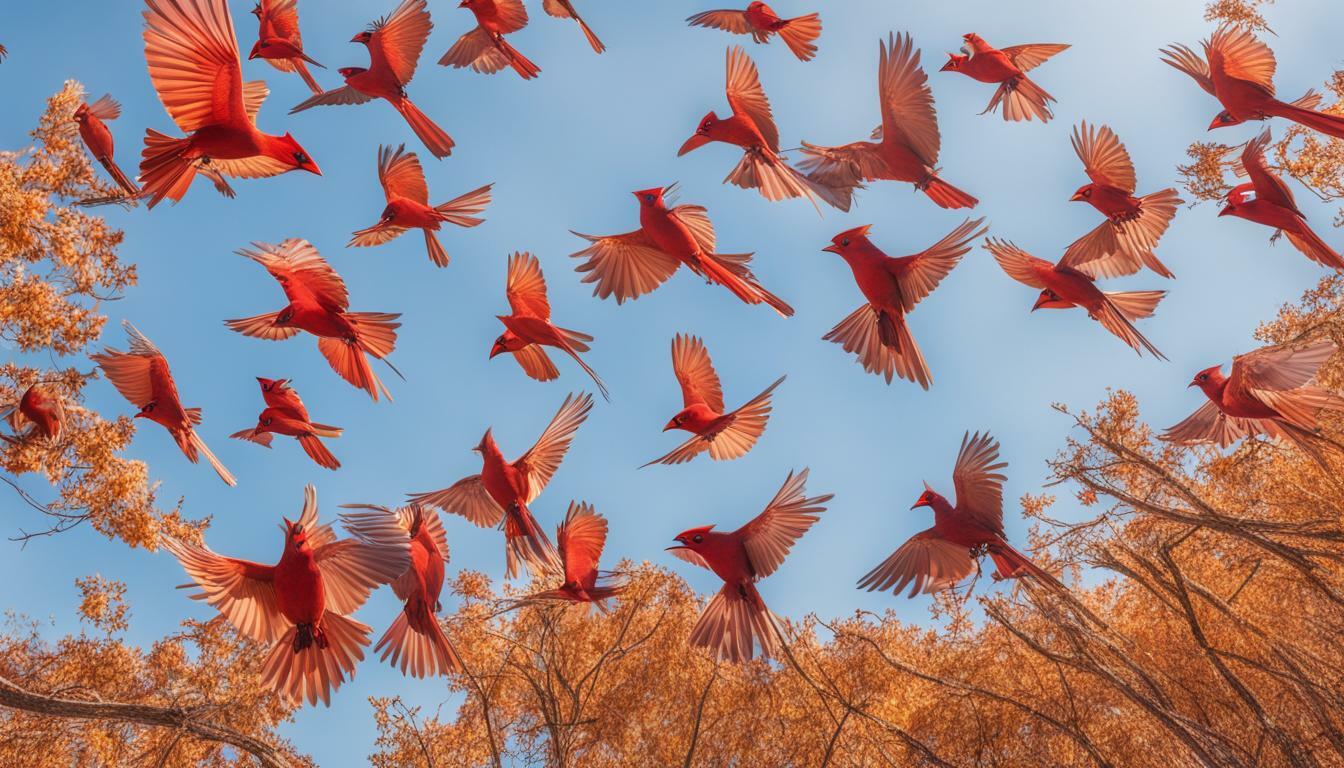Have you ever wondered if cardinal birds migrate? Cardinals are known for their striking red feathers and beautiful songs, but their migratory behavior is less well-known. Understanding cardinal migration patterns is important for conservation efforts and can also provide fascinating insights into the behavior of these vibrant birds.
Key Takeaways:
- Cardinals do migrate, although not all populations migrate.
- Understanding cardinal migration can help with conservation efforts.
- Cardinal migration behavior is influenced by factors such as climate and seasonality.
Understanding Cardinal Migration Behavior
Cardinals are known for their vibrant red plumage and melodious songs, but they are equally remarkable for their annual migration habits. Understanding cardinal migration behavior is crucial to the conservation of these beautiful birds and their habitats.
So, why do cardinals migrate? One reason is to seek out more favorable breeding and feeding conditions. As the seasons change and temperatures drop, cardinals leave their breeding grounds and travel to warmer regions with abundant food sources. During migration, cardinals exhibit unique behavior, such as flying at lower altitudes and in smaller groups compared to other migratory bird species.
Cardinals typically migrate twice a year, in spring and fall, covering an average distance of 500-700 miles. The exact timing of migration can vary depending on factors such as weather patterns, daylight hours, and food availability. Northern populations of cardinals tend to migrate earlier than southern populations, as their breeding season starts earlier.
During migration, cardinals follow established routes, but they are also known to adapt to changes in their environment. For example, if a food source dries up or a habitat becomes unsuitable, cardinals may alter their migration route or destination in search of better conditions.
In summary, understanding cardinal migration habits and behavior is essential for their conservation. By studying their patterns, scientists and conservationists can better protect cardinal populations and their habitats.
When Do Cardinals Migrate?
Cardinal migration is a seasonal event that usually takes place twice a year: in the spring and fall.
In the spring, northern cardinals begin to migrate northward, towards their breeding grounds. This typically occurs in late February to early May, depending on the location and climate. In the fall, cardinals migrate southward, often in flocks, to avoid the colder temperatures and shortage of food during the winter months. Fall migration typically occurs from September to December.
While the timing of migration may vary slightly depending on the population and location of cardinals, research has shown that environmental cues such as daylight hours, temperature, and food availability play a significant role in triggering migration.
For example, recent studies have suggested that global warming may be causing changes in the timing of cardinal migration. Warmer temperatures are causing trees to leaf out earlier, which means that the food sources that cardinals rely on may become available earlier than usual. As a result, cardinals may be adjusting their migration schedules to take advantage of these food sources.
Overall, understanding when cardinals migrate is important for conservation efforts and for predicting changes in migratory patterns due to climate change. By monitoring migration patterns and identifying the factors that influence them, researchers and conservationists can work towards protecting cardinal populations and preserving their habitats.
Cardinal Migration Routes and Destinations
Cardinals are known for their vibrant feathers, but they are also well-known for their remarkable migratory patterns. During migration, cardinals travel long distances to reach their destinations, which are often determined by habitat and resources. So, where do cardinals go during migration?
Cardinal bird migration can cover a range of routes and destinations. Some cardinals migrate from the southern United States to northern regions, such as the Great Lakes or New England. Others migrate from eastern regions to central and western parts of the country. During migration, cardinals may also travel to Mexico and other parts of Central America.
The routes and destinations of cardinals can vary depending on the population and location. Eastern populations tend to migrate to the south, while western populations may head east. Cardinals that breed in the north tend to migrate southward, avoiding the harsh winter conditions.
During migration, cardinals may make stops at significant sites along their route. These stopover sites provide necessary resources, such as food and shelter, that are critical for their journey. Some common stopover sites for migrating cardinals are forests, shrublands, and wetlands.
Overall, understanding the routes and destinations of cardinals during migration is vital to their conservation and protection. By recognizing the important stopover sites and habitats, we can work to ensure their survival and continuity.
The Impact of Climate on Cardinal Migration
If you’re wondering whether northern cardinals, like many other bird species, migrate, the answer is yes. Their migratory behavior is influenced by a variety of factors, including climate.
Climate plays a significant role in the timing and pattern of cardinal migration. In general, northern cardinals migrate during the fall and winter months, with populations closer to the Arctic Circle beginning their journey earlier in the season. The timing of their migration is often triggered by changes in daylight and temperature.
However, changing weather patterns and climate conditions are beginning to impact their migratory behavior. Studies have shown that rising global temperatures are causing some bird species to shift their migration patterns or alter their routes altogether.
As for northern cardinals, research suggests that their migratory behavior may be affected by the availability of food and water along their routes. In areas where climate change is causing drought or changes in vegetation, cardinals may be forced to adapt their migration patterns in search of resources.
The migratory behavior of cardinals is a fascinating aspect of their biology that is still being explored and understood. As their habitats and food sources continue to be threatened by climate change, it’s important to monitor and protect their populations to ensure their survival.
The Importance of Cardinal Conservation during Migration
Cardinals are magnificent birds that travel long distances during migration. However, their migratory habits make them vulnerable to various threats. Therefore, it is crucial to conserve cardinals and their habitats to ensure their survival. In this section, we will discuss the cardinal migration habits and the significance of conserving these splendid birds during migration.
Cardinals are an important indicator of the health of ecosystems. They play a vital role in insect control, seed dispersion, and pollination, making them an essential part of the food chain. However, the loss of habitats due to human activities such as deforestation, urbanization, and agricultural expansion has led to a significant decline in cardinal populations. To ensure their conservation, it is essential to protect their habitats, including breeding and wintering areas, stopover sites, and migration routes.
The United States has several conservation programs aimed at protecting cardinal habitats and populations. For instance, the United States Fish and Wildlife Service (USFWS) has implemented the Migratory Bird Treaty Act of 1918, which prohibits the hunting, capturing, killing, or selling of migratory birds, including cardinals. Additionally, the North American Bird Conservation Initiative (NABCI) has developed a bird conservation plan that focuses on habitat conservation, research, and monitoring, public outreach, and policy development to ensure the survival of migratory birds.
Individuals and communities can also help conserve cardinals by implementing bird-friendly practices, such as planting native vegetation, avoiding the use of pesticides, and providing bird feeders and nesting boxes. These practices can create a welcoming environment for cardinals and contribute to their conservation.
In conclusion, the migratory habits of cardinals make them vulnerable to various threats, including habitat destruction, climate change, and human activities. Therefore, it is crucial to conserve cardinals and their habitats during migration to ensure their survival. By implementing conservation measures, both at the individual and community level, we can protect these exquisite birds for future generations.
Conclusion
Cardinals are known for their vibrant plumage and cheerful songs, but their migratory behavior is just as remarkable. Understanding cardinal migration patterns is crucial for conservation efforts and provides valuable insights into the impact of climate change on wildlife.
Through this article, we have explored the migratory behavior of cardinals, their timing, routes, and destinations, as well as the influence of climate on their travels. We have also highlighted the challenges cardinals face during migration and the steps that can be taken to protect their populations.
As you marvel at the beauty of cardinals in your backyard, remember that these birds embark on incredible journeys each year. By appreciating their migratory behavior and supporting conservation efforts, we can help ensure that future generations can enjoy the sight of these amazing birds.
How Do Birds Reproduce and Migrate at the Same Time?
Birds possess fascinating facts about bird reproduction and migration that enable them to undertake both processes simultaneously. During reproduction, male birds court females through elaborate displays and songs, while females produce eggs that are fertilized internally. These eggs are then incubated until they hatch. Once the young birds are ready, they join their parents in the remarkable journey of migration, traveling great distances to find suitable breeding and feeding grounds. This incredible ability to reproduce and migrate simultaneously showcases the adaptability and resilience of these avian creatures.
FAQ
Q: Do cardinals migrate?
A: Yes, cardinals migrate. They are considered partially migratory birds, meaning that while some individuals may stay in their breeding territories year-round, others will migrate to different regions.
Q: Why do cardinals migrate?
A: Cardinals migrate in search of more abundant food sources and suitable breeding grounds. They also migrate to avoid harsh weather conditions.
Q: When do cardinals migrate?
A: Cardinal migration typically occurs in the spring and fall. In the spring, they migrate northward to their breeding areas, while in the fall, they migrate southward to their wintering grounds.
Q: Where do cardinals go during migration?
A: Cardinals undertake various migration routes and destinations. In the spring, they can be found in the northeastern and midwestern United States, as well as parts of southern Canada. In the fall, they travel southward to southern states, including Florida and Texas.
Q: How does climate affect cardinal migration?
A: Climate plays a significant role in cardinal migration. Changing weather patterns and climate conditions can impact the timing and behavior of cardinals during migration. It may also lead to shifts or adaptations in their migration patterns.
Q: Why is cardinal conservation important during migration?
A: Cardinal conservation during migration is crucial to safeguard their populations and habitats. Migration poses challenges for cardinals, including threats from predators and loss of suitable stopover sites. Conservation efforts can help mitigate these risks and support their survival.










